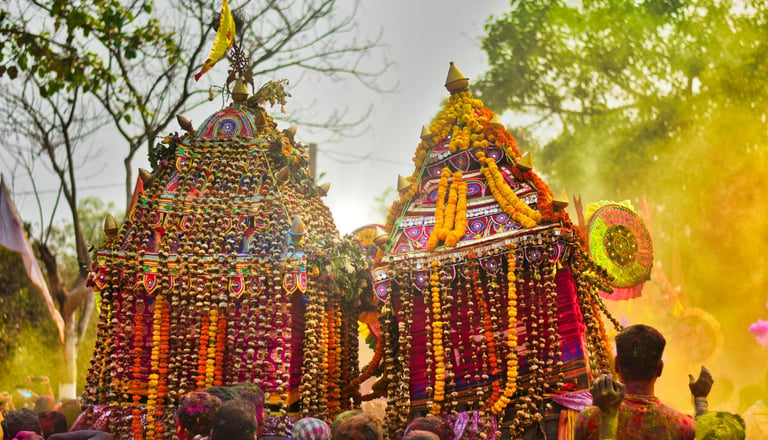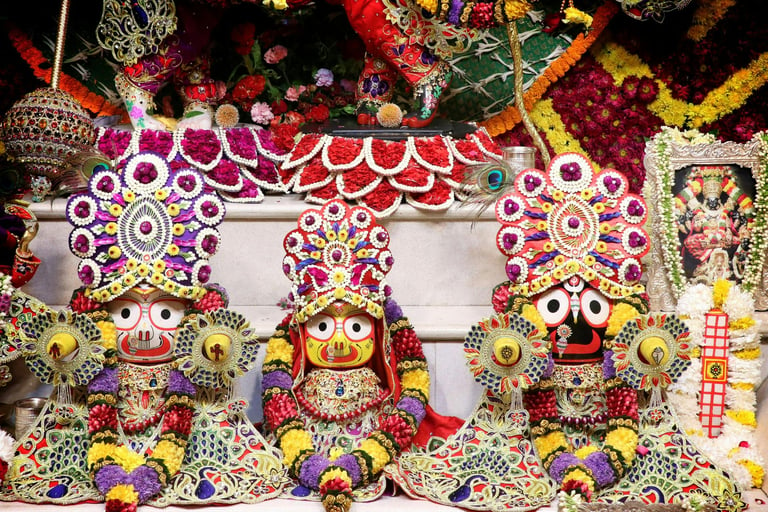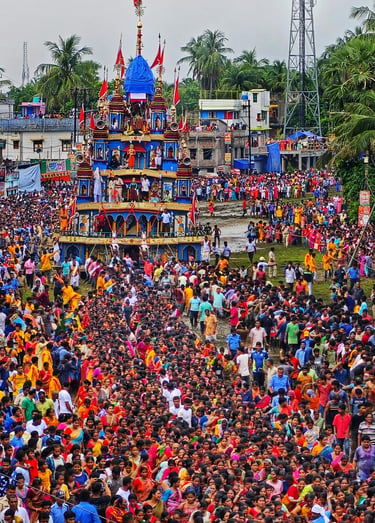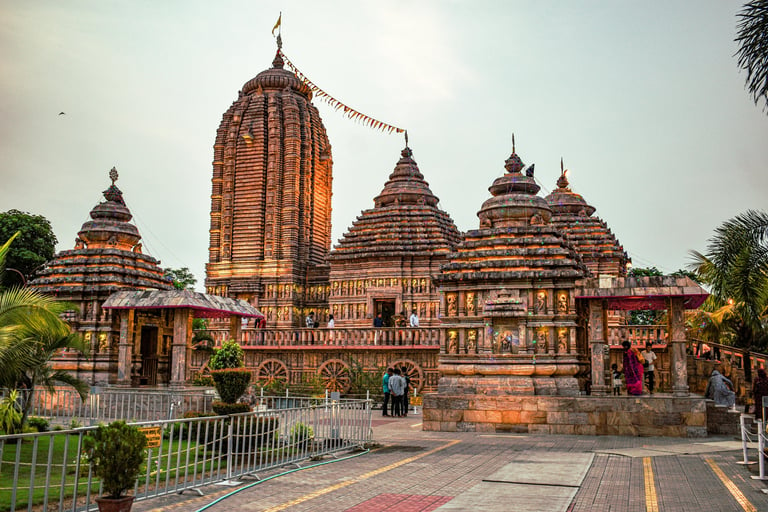Rathayatra: When the Temple Walks the Street
This article takes you into the heart of Rathayatra when Lord Jagannath leaves the sanctum and moves through streets lined with hope and devotion. It is more than history or ritual; it is a moment when the divine draws close, reminding us that faith is not meant to stay behind temple walls, but to walk with us, among us. Step in and discover how a city becomes a temple, and how an age-old journey continues to unite hearts across time.
CULTUROSCOPE


With the arrival of monsoon, the town of Puri in Odisha begins its quiet preparations for one of its most cherished festivals. Streets are decorated, the great chariots slowly take shape under the hands of skilled craftsmen, and arrangements are made to welcome countless devotees from near and far. This is Rathayatra — the sacred journey of Lord Jagannath to his maternal home.
For generations, this tradition has drawn hearts together in shared devotion. During these days, the Lord steps beyond the walls of his grand temple and moves through the very streets where people live, work, and wait with hope. Even those who cannot enter the sanctum find themselves included, as the divine presence meets them where they stand. And so, Rathayatra becomes more than a ritual; it becomes a gentle reminder that faith is at its most powerful when it walks beside us, turning roads into shrines and crowds into a single, waiting prayer.
Rathayatra in Odisha is considered one of the world’s most ancient and revered religious festivals. At its heart lies a symbolic journey: Lord Jagannath, along with his elder brother Balabhadra and sister Subhadra, leaves their royal abode in the Jagannath Temple and travels nearly three kilometres to the simpler, quieter Gundicha Temple.
Yet this is far more than a retelling of legend. Enriched with grandeur, deep emotion, and centuries-old rituals, it becomes a living celebration of the Lord’s closeness to his devotees. In these moments, the divine does not remain apart; it steps forward into the heart of the waiting crowd, turning an age-old story into an experience shared by all.
Regarded as the spiritual and cultural heart of Odisha, the Jagannath Temple in Puri was built in the 12th century CE by King Anantavarman Chodaganga. Over time, this grand temple became the principal centre for the worship of Lord Jagannath, revered as a distinctive form of Vishnu. Rooted in history, devotion, and tradition, it stands not only as an architectural marvel but also as a living symbol of faith that continues to shape the region’s identity.
Newly crafted each year from sacred wood, the towering chariots carry the gods through the waiting streets, turning devotion into a moving festival.
The story of the Jagannath Temple is closely tied to an old legend of faith. In the ancient kingdom of Avantipur, there once ruled King Indradyumna, whose devotion to Lord Vishnu was deep and unwavering. One day, he heard from a wandering traveller about Neela Madhava, a sacred form of Krishna worshipped in a hidden forest shrine. From that moment, the king’s heart was set on beholding this divine presence himself.
It is said that Lord Vishnu appeared to him in a dream. The message was gentle yet clear: to build a temple and install within it the idols of Jagannath, Balabhadra, and Subhadra, crafted not from stone but from sacred wood. Guided by this vision, the king began his work with quiet determination.
Wood was brought from deep forests, selected through age-old rituals, and the sacred task of carving the deities was entrusted to Vishwakarma, the divine architect. Vishwakarma agreed, but on one condition: until his work was finished, no one should interrupt him. The king, in humility and faith, gave his word, and so, in silence and devotion, away from every curious gaze, the sacred images slowly took form.
Days passed in quiet anticipation, but over time, King Indradyumna grew restless. Carried by hope and curiosity, he went to see the work with the queen at his side. Yet by entering before the task was complete, he unknowingly broke the promise he had given. Disturbed midway, Vishwakarma withdrew, leaving the images unfinished. The deities remained with open, watchful eyes and incomplete limbs, yet still holding a silent grace.
With no other choice, the king installed the deities just as they were, trusting that true divinity lies not in perfect shape, but in the depth of devotion that calls it forth. And so, even today, within the sanctum of the Jagannath Temple, the Lord stands in this unique form — incomplete in appearance yet complete in spirit, his open gaze welcoming all who come before him.
King Indradyumna’s deep devotion shaped Jagannath worship into something truly unique. Unlike most temples where deities are carved from stone, here the sacred images were created from chosen wood, prepared through age-old rituals. Their wide, ever-open round eyes and unfinished limbs break away from traditional forms, yet they speak of a deeper truth: a divine presence beyond shape, watching the world with calm, unblinking grace.
In Jagannath’s special form, devotees see not limitation but an endless, formless spirit that embraces all. Beside him, his elder brother Balabhadra represents quiet strength, while his sister Subhadra stands for grace and balance. Together, they place the gentle warmth of sibling love at the very heart of devotion, reminding us that the divine is not only distant and mighty, but also near, tender, and shared.
Every year, once during Rathayatra, the divine siblings set out from their grand temple on a journey to their maternal home. On this day, they leave the quiet sanctum and ascend newly built, richly adorned chariots crafted just for them. These chariots are never reused; instead, each year they are made anew from sacred wood, chosen through ancient rituals that honour both tradition and nature.
The search for this sacred wood begins with the Banajaga Yatra, a ritual journey deep into the forests. Guided by prayer and custom, temple servitors and priests look for special trees like phassi, dhaura, and simili, each believed to hold divine blessing. When the chosen trees are found, they are respectfully felled in solemn ceremony and carefully brought back to Puri.
In Puri, master craftsmen known as Maharanas craft the chariots entirely by hand. They follow no written plans and use no modern tools, relying instead on skills and devotion handed down through generations. Without a single iron nail, each towering chariot takes shape, held together by wooden pegs and intricate joinery, transforming timber into moving shrines.
After the festival ends, the chariots are gently dismantled. Some parts are offered at auction to eager devotees, while the remaining sacred wood is taken to the temple kitchen, where it becomes firewood. Even then, it continues to serve, carrying forward the warmth and memory of the festival into daily life.
The festival features three grand chariots. Nandighosha, with sixteen wheels, carries Lord Jagannath. Taladhwaja, built with fourteen wheels, is prepared for his brother Balabhadra. Darpadalana, with twelve wheels, carries their sister Subhadra.
Each chariot comes alive with bright colours and sacred motifs, turning wood and cloth into something deeply spiritual. As they move through the streets, these chariots become living temples, carrying centuries of faith and tradition into the hearts of all who gather to see them.
Before the grand Rathayatra begins, a quiet yet powerful ritual takes place. The Gajapati King of Puri, regarded as the foremost servitor of Lord Jagannath, sets aside his royal robes and dresses in simple cloth. With a golden-handled broom in hand, he gently sweeps the wooden platforms of the chariots. This act, known as Chera Pahanra, is both humble and deeply symbolic.
After the sweeping, sandalwood-scented water and fresh flowers are sprinkled over the chariots to sanctify them. Though it may seem simple, this gesture carries a profound message: in the presence of the divine, everyone stands as a servant, regardless of power or title.
Today, this tradition continues under the care of Dibyasingha Deb, the ceremonial head of Puri’s royal family, whose quiet devotion still guides the temple’s spiritual life.
Once this ritual is complete, the festival comes alive in full spirit. Amid joyful cheers, the beat of drums, and the echo of conch shells, thousands of devotees take hold of the thick ropes tied to the chariots and begin to pull. With their united strength and unwavering faith, the mighty chariots move forward. Rolling through the heart of the city, the Lord journeys to his maternal home, blessing every devotee along the way.
After the joyous pull of the chariots through Puri’s crowded streets, the journey finds its pause in the calm courtyard of the Gundicha Temple, fondly known as the maternal home of Lord Jagannath. Away from the grandeur and daily bustle of the main temple, this peaceful sanctuary offers a softer welcome. Here, Jagannath rests alongside his brother Balabhadra and sister Subhadra for seven days, accepting simple offerings and prayers that feel as gentle as a mother’s care.
The temple is named after Queen Gundicha, the devoted wife of King Indradyumna, whose love and dedication still seem to linger in its quiet walls. In the hearts of devotees, she lives on as a foster mother to the Lord, turning this yearly journey into something deeper than tradition. It becomes a return to warmth and belonging. Even today, this gentle devotion softens the grandeur of the festival, filling it with the quiet grace of coming home.
On the fifth day of the deities’ stay at Gundicha Temple, a special ritual known as Hera Panchami adds gentle tension to the festival. On this day, Goddess Lakshmi, who remained in the main temple, makes her way to Gundicha to visit Lord Jagannath. Her visit carries both affection and a soft complaint for being left behind.
Lakshmi is carried in a beautifully decorated palanquin, accompanied by music and prayers. When she reaches the temple, she is welcomed with devotion. In a symbolic act of mild displeasure, her attendants slightly damage a part of Jagannath’s chariot, Nandighosha. Afterwards, instead of returning along the main road, Lakshmi quietly slips back to the main temple by a separate route. Through this simple yet meaningful ritual, the divine relationship is portrayed in very human terms, blending love, longing, and gentle reproach into the heart of the celebration.
At the end of the week, the deities begin their return journey to the main temple, known as the Bahuda Yatra. Along the way, the chariots pause briefly at the Mausi Maa Temple, where Lord Jagannath receives his beloved offering of Poda Pitha, a simple roasted rice cake. This moment feels intimate and familial, adding gentle warmth to the grand procession.
Once they return to the temple, Lord Jagannath is adorned in the Suna Besha, clothed in shimmering gold ornaments and robes. In this resplendent form, he offers darshan to countless devotees, radiating divine grace and splendour that mark the festival’s most glorious moment.
Rathayatra is not merely a religious festival; it is a symbolic journey of the soul. The chariot itself is seen as the human body, carrying within it the living spirit of the divine. When thousands of devotees gather to pull the ropes, this simple act becomes something deeper, an expression of longing to draw the divine closer to the heart and to make space for the sacred in daily life.
Over the years, Rathayatra has travelled beyond the ancient streets of Puri, finding its way into hearts and cities across the world. Through the devotion of ISKCON and countless spiritual communities, this timeless celebration is now observed in many lands, each keeping alive the same spirit of faith, togetherness, and quiet joy that makes the divine feel so near.
Even though the inner sanctum of the Jagannath Temple remains closed to non-Hindus, during Rathayatra the Lord steps beyond those ancient walls, not only to bless but to belong. In that sacred crossing, no gate divides, and no name or origin keeps anyone apart. The chariots carry far more than carved wood and painted cloth; they hold centuries of prayer, the vision of a king who saw God in the simplest form, the quiet devotion of a queen whose care made room for the divine, the hopes of pilgrims who return year after year, and the gentle grace of a deity who chooses closeness over distance.
In Rathayatra, the temple does not merely open its doors to the world; it moves among the people. The chariots become travelling sanctuaries, the city itself becomes a living temple, and for a few luminous days, the world feels gathered into the tender fold of something timeless and compassionate.
Jai Jagannath.
Subhalakshmi Buragohain




Crowds roar, drums beat — it’s Rath Yatra on the move!
Unfinished yet divine, where wholeness lies beyond form.


Puri Jagannath Temple:
Where the Gods don’t just reside, they travel with you.
